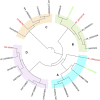Engineering of Reductive Aminases for Asymmetric Synthesis of Enantiopure Rasagiline
- PMID: 35004654
- PMCID: PMC8727753
- DOI: 10.3389/fbioe.2021.798147
Engineering of Reductive Aminases for Asymmetric Synthesis of Enantiopure Rasagiline
Abstract
Reductive aminases (RedAms) for the stereoselective amination of ketones represent an environmentally benign and economically viable alternative to transition metal-catalyzed asymmetric chemical synthesis. Here, we report two RedAms from Aspergillus calidoustus (AcRedAm) and bacteria (BaRedAm) with NADPH-dependent features. The enzymes can synthesize a set of secondary amines using a broad range of ketone and amine substrates with up to 97% conversion. To synthesize the pharmaceutical ingredient (R)-rasagiline, we engineered AcRedAm through rational design to obtain highly stereoselective mutants. The best mutant Q237A from AcRedAm could synthesize (R)-rasagiline with >99% enantiomeric excess with moderate conversion. The features of AcRedAm and BaRedAm highlight their potential for further study and expand the biocatalytic toolbox for industrial applications.
Keywords: chiral amine; rasagiline; rational design; reductive aminase; site saturation mutagenesis.
Copyright © 2021 Zhang, He, Zhu, Zhang, Tang, Cui and Feng.
Conflict of interest statement
The authors declare that the research was conducted in the absence of any commercial or financial relationships that could be construed as a potential conflict of interest.
Figures







Similar articles
-
Asymmetric synthesis of primary amines catalyzed by thermotolerant fungal reductive aminases.Chem Sci. 2020 May 5;11(19):5052-5057. doi: 10.1039/d0sc02253e. Chem Sci. 2020. PMID: 34122962 Free PMC article.
-
A reductive aminase from Aspergillus oryzae.Nat Chem. 2017 Oct;9(10):961-969. doi: 10.1038/nchem.2782. Epub 2017 May 29. Nat Chem. 2017. PMID: 28937665
-
Biocatalysis in Drug Design: Engineered Reductive Aminases (RedAms) Are Used to Access Chiral Building Blocks with Multiple Stereocenters.J Am Chem Soc. 2023 Oct 11;145(40):22041-22046. doi: 10.1021/jacs.3c07010. Epub 2023 Oct 2. J Am Chem Soc. 2023. PMID: 37782882 Free PMC article.
-
[NAD(P)H-dependent oxidoreductases for synthesis of chiral amines by asymmetric reductive amination of ketones].Sheng Wu Gong Cheng Xue Bao. 2020 Sep 25;36(9):1794-1816. doi: 10.13345/j.cjb.190582. Sheng Wu Gong Cheng Xue Bao. 2020. PMID: 33164457 Review. Chinese.
-
Synthesis of chiral amines using redox biocatalysis.Curr Opin Chem Biol. 2018 Apr;43:15-22. doi: 10.1016/j.cbpa.2017.09.008. Epub 2017 Oct 31. Curr Opin Chem Biol. 2018. PMID: 29100099 Review.
Cited by
-
Structure of the imine reductase from Ajellomyces dermatitidis in three crystal forms.Acta Crystallogr F Struct Biol Commun. 2023 Sep 1;79(Pt 9):224-230. doi: 10.1107/S2053230X23006672. Epub 2023 Aug 15. Acta Crystallogr F Struct Biol Commun. 2023. PMID: 37581897 Free PMC article.
References
LinkOut - more resources
Full Text Sources

